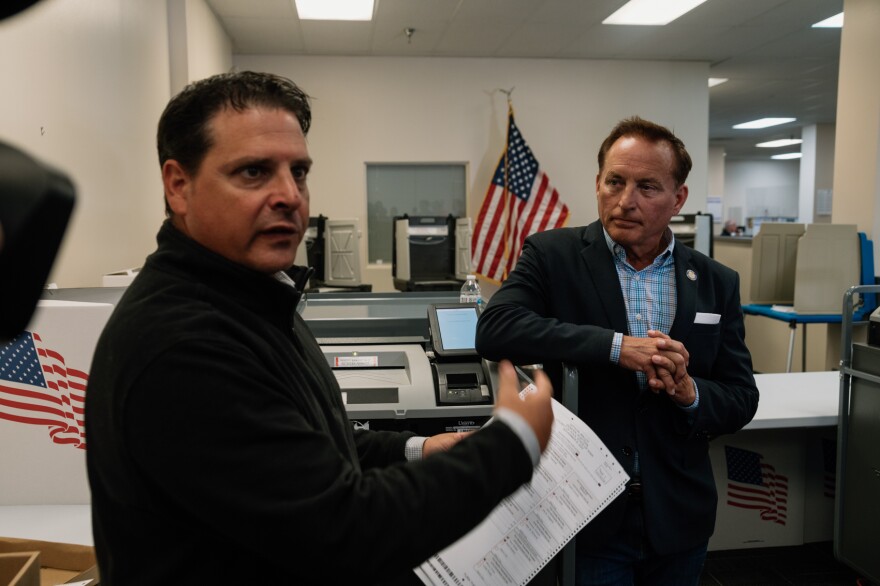County election officials across Iowa have been testing their vote counting machines for accuracy ahead of Election Day, when Iowans will vote on paper ballots and feed them into the tabulators that tally up the votes.
Iowa Secretary of State Paul Pate was recently at the Polk County Elections Office in Des Moines for a public testing of the tabulators. He said he wanted to show voters election security and integrity measures that are in place.
“I want them to see up close and personal what we’re doing so they have total confidence in the results,” Pate said. “The worst thing that can happen to us—the worst thing—is people don’t have confidence and don’t believe the election results. Because if that happens, our democracy has fallen.”
Polk County Election Director John Chiodo went through the process of testing a tabulator last week in front of several reporters and TV cameras. His office repeats that process more than 200 times to check all the machines in Iowa’s largest county.
“We test and test and test and test so you have that comfort, waking up on Election Day, that things are going to go right,” he said.
Chiodo prepared several test ballots, some marked correctly, some marked with more than one name for the same office, and others with offices left blank. As he fed them into the tabulator, the machine alerted him when too many names were selected and when fields were left blank.
“At that time, the voter has a chance to correct it,” Chiodo said. “It means spoil that ballot and we issue them a new one. Or, if they say, ‘You know what, I spent 15 minutes trying to mark my ballot. I don’t care about that race,’ they will accept it. It’ll count every other race correct except for the one race that was over-voted.”
Chiodo said the over- and under-votes are also shown on the count provided by the machine after polls close.
Pate said poll workers have to account for all the ballots the polling place starts with on Election Day.
“If they start out with 100 ballots, at the end of the day, they have to show how many were voted, how many were spoiled, how many weren’t used, and should total up to be the same number,” Pate said. “That’s crucial.”
How are tabulators used on Election Day?
Chiodo said the machines are programmed for the precinct they’re at—and the machines won’t accept ballots from other precincts.
“The first thing you do in the morning, the poll workers have to provide a zero tape to make sure everything that’s on the machine for that precinct is reading zeros,” Chiodo said.
“That’s a double check because they’ve already done it here,” Pate said of the testing in the county elections office. “But we want to make sure, even though the machine is all sealed and sitting, nobody has tampered with it in the time in between.”

Pate said counties have backup tabulators in case some stop working on Election Day and need to be replaced.
As voters place their paper ballots in the tabulator, the machine tallies votes, and the paper ballots are kept locked inside the machine as voting continues.
“This box is big…because we put the ballots for the whole day in here,” Pate said. “We don’t want to be opening it up during the day, because that gets people nervous.”
After the polls close, the vote count from each machine is stored on a flash drive and prints out on a paper receipt. Those can later be compared to the paper ballots stored inside the tabulator.
Chiodo said after polls close, the tabulators are briefly connected to a cellular network to transmit unofficial election results to county election officials.
“The only time that it has any connection whatsoever is at the end of the night, when we enable a modem to transfer the results from the polling place to here,” Chiodo said. “And it’s outgoing only. And that’s only live for when they close the machine out. And there’s safeguards on both ends as far as who can get in, who can get out. And it’s only outgoing data. And that’s unofficial results.”
Pate said the official results are not transmitted in that way. Election results are official about one week after Election Day, when each county canvass of votes occurs.
He said shortly after the election, his office picks a precinct in each of Iowa’s 99 counties to be manually audited.
“They will hand count all those ballots for the top office,” Pate said. “And then they would compare it to what the tabulator said, and they have to match. And we’ve been doing this now for about three election cycles. And I was glad we implemented this policy. Every time, it’s checked out 100 percent, all 99 counties.”
If a recount is requested in a close race, the paper ballots are recounted. Pate said in his experience, the tabulators are “far more accurate” than people hand-counting votes.
“It might take them four times to have the people who are all counting it to come up with the right number, and it would be the same number the machine had,” Pate said.
Early voting begins Oct. 19 and Election Day is Nov. 8. Click here for more information about voting from the Iowa Secretary of State's office.






